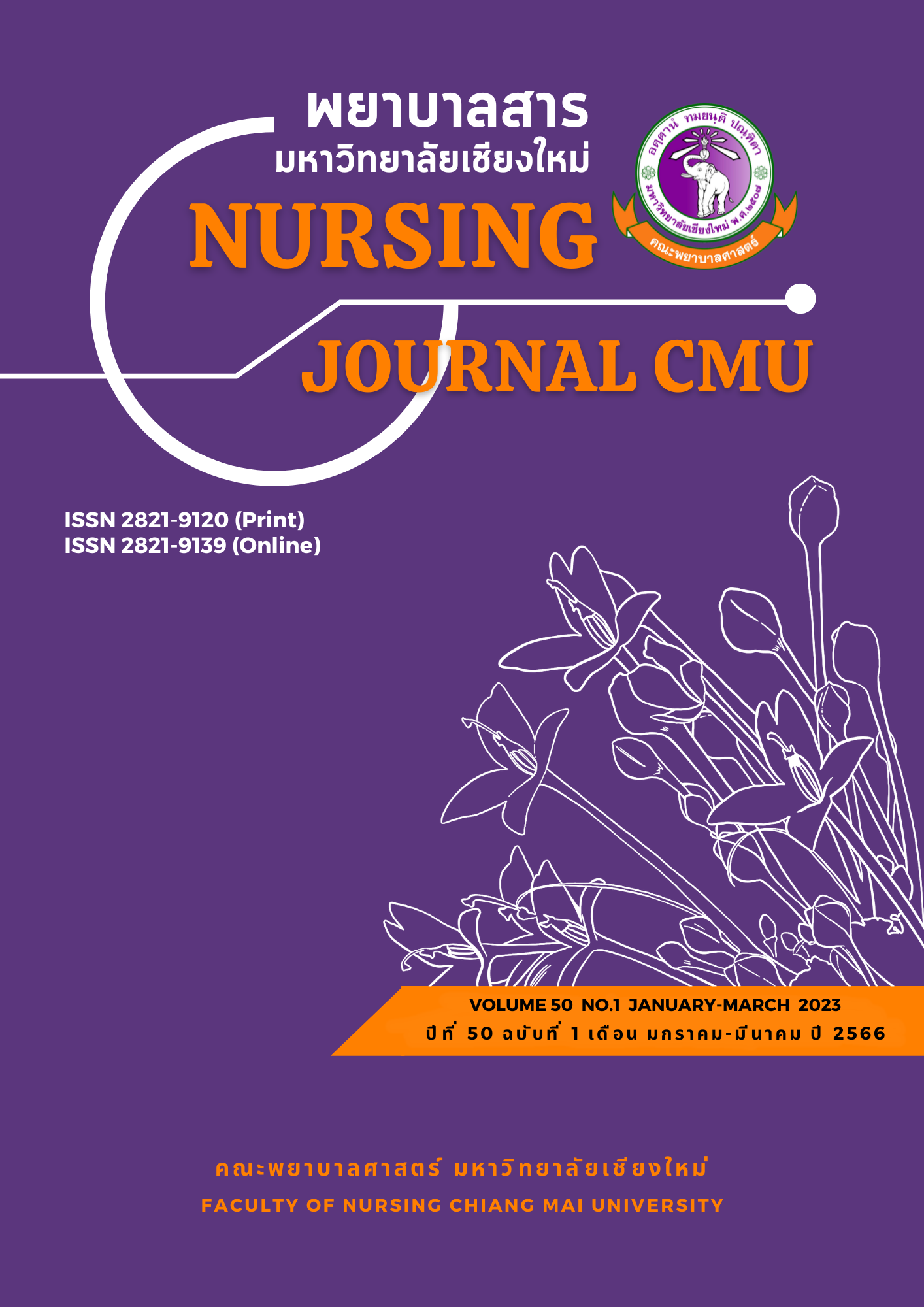The Effects of Nordic Walking Exercise on Physical Fitness Among Older Persons
Keywords:
Exercise, Nordic walking, Physical fitness, Older personAbstract
During the process of aging, there is a decrease in physical fitness. Exercising for physical fitness enhances daily living activities among the elderly. The Nordic Walking Exercise is a moderately intense aerobic exercise which can improve physical fitness. The purpose of this experimental research was to examine the effect of the Nordic Walking Exercise on older persons’ physical fitness. Participants included 36 older persons in Chiang Mai province, who were purposely selected and randomly assigned to an experimental group or a control group, with 18 persons in each group. The experimental group was trained on how to do the Nordic Walking Exercise three times a week for twelve weeks, while those in the control group did not do this exercise. The measurement tools consisted of 1) the demographic data recording form; 2) the recording form for the four components of fitness; 3) the Nordic Walking Exercise Guidelines for older persons; 4) the Nordic Walking Exercise handbook for older persons; 5) Nordic poles; and 6) a heart rate monitor. Data was analyzed using descriptive statistics, and the hypotheses were tested by t-test.
The results revealed that:
- The mean of cardiorespiratory endurance, muscle strength, and flexibility in the experimental group after doing the Nordic Walking exercise was significantly higher than before doing the exercise (p < .001). However, the mean of body composition in the experimental group after doing the Nordic Walking exercise was not statistically significantly different.
- The mean of cardiorespiratory endurance and flexibility in the experimental group after doing the Nordic Walking exercise was significantly higher than that of the control group (p < .01 and p < .05, respectively). However, mean muscle strength and body composition in the experimental group were not statistically significantly different from the control group.
Nordic walking exercise can increase physical fitness, especially cardiorespiratory endurance, and flexibility. Therefore, nurses should apply this exercise to promote older persons for continuing efficient physical fitness.
References
American College of Sports Medicine. (2006). ACSM’s guideline for exercise testing and prescription (7th ed.). Baltimor: Lippincott Williams & Wilkins.
American College of Sports Medicine. (2011). ACSM’s guidelines for exercise testing and prescription. (7th ed.). Philadelphia: Lippincott Williams & Wilkins.
Bellew, J. W., Symons, T. B., & Vandervoort, A. A. (2005). Geriatric fitness: Effects of aging and recommendations for exercise in older adults. Cardiopulmonary Physical Therapy Journal, 16, 21-32.
Church, T. S., Earnest, C. P., & Morss, G. M. (2002). Field testing of physiological responses associated with Nordic Walking. Research Quarterly for Exercise and Sport, 73(3), 296-300.
Kocur, P., & Wilk, M. (2006). Nordic walking–a new form of exercise in rehabilitation. Medical Rehabilitation, 10(2), 1-8.
Kuo, J. C., Han, X., Hsiao, C. T., Yates, J. R., & Waterman, C. M. (2011). Analysis of the myosin-II-responsive focal adhesion proteome reveals a role for β-Pix in negative regulation of focal adhesion maturation. Nature Cell Biology, 13(4), 383–393. doi: 10.1038/ncb2216
Lasuka, D., Khampolsiri, T., Sucamvang, K., Chintanawat, R., & Riyakad, A. (2014). The Nordic walking exercise guidelines for older persons. Chiang Mai: Faculty of Nursing, Chiangmai University.
Song, M. S., Yoo, Y. K., Choi, C. H., & Kim, N. C. (2013). Effects of Nordic walking on body
composition, muscle strength, and lipid profile in elderly women. Asian Nursing Research, 7(1), 1–7. doi: 10.1016/j.anr.2012.11.001
St-Onge, M. P., & Gallagher, D. (2010). Body composition changes with aging: The cause or the result of alterations in metabolic rate and macronutrient oxidation? Nutrition, 26(2), 152–155. doi: 10.1016/j.nut.2009.07.004
Takeshima, N., Islam, M. M., Rogers, M. E., Rogers, N. L., Sengoku, N., Koizumi, D., … Naruse,
A. (2013). Effects of Nordic walking compared to conventional walking and band-based resistance exercise on fitness in older adults. Journal of Sports Science and Medicine, 12(3), 422-430.
Virág, A., Karóczi, C. K., Jakab, A., Vass, Z., Kovács, É., & Gondos, T. (2014). Short-term and long-term effects of Nordic walking training on balance, functional mobility, muscle strength and aerobic endurance among Hungarian community-living older people: A feasibility study. The Journal of Sports Medicine and Physical Fitness, 55(11), 1285-1292.
Downloads
Published
How to Cite
Issue
Section
License
Copyright (c) 2023 Nursing Journal

This work is licensed under a Creative Commons Attribution-NonCommercial-NoDerivatives 4.0 International License.
บทความที่ได้รับการตีพิมพ์เป็นลิขสิทธิ์ของวารสารพยาบาลสาร
ข้อความที่ปรากฏในบทความแต่ละเรื่องในวารสารวิชาการเล่มนี้เป็นความคิดเห็นส่วนตัวของผู้เขียนแต่ละท่านไม่เกี่ยวข้องกับมหาวิทยาลัยเชียงใหม่ และคณาจารย์ท่านอื่นๆในมหาวิทยาลัยฯ แต่อย่างใด ความรับผิดชอบองค์ประกอบทั้งหมดของบทความแต่ละเรื่องเป็นของผู้เขียนแต่ละท่าน หากมีความผิดพลาดใด ๆ ผู้เขียนแต่ละท่านจะรับผิดชอบบทความของตนเองแต่ผู้เดียว






